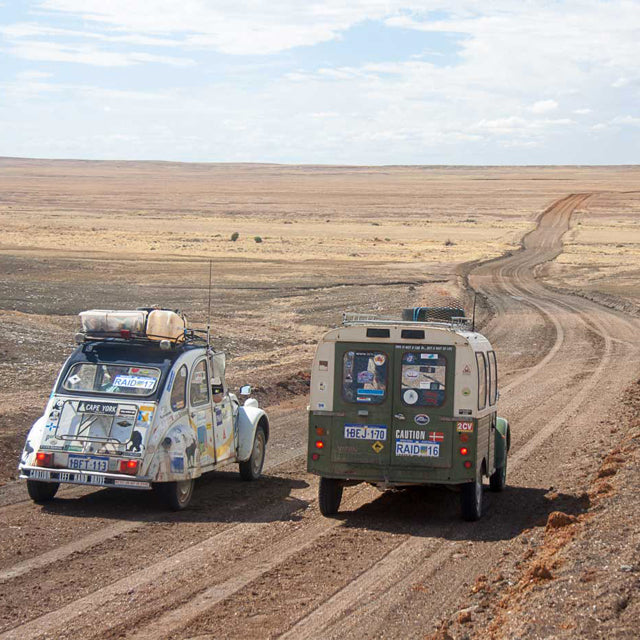They were our transportation over four weeks. Covered in stickers from all over the world, the journey we have in mind makes a lot of travellers jealous: the plan is drive them from Melbourne all the way to the centre of Australia, Alice Springs. We borrowed the cars up from a guy who seems to spend a lot of time in his garage—apart from four 2CV projects in his garden, we count three DS models in his shed!
We christen the 2CVs ‘Heurtebise’ and the ‘Viking Van’.
Fully packed with the necessary camping gear, a 4x4 road map and a Garmin satellite navigation system with detailed maps, we set off on our journey through this beautiful continent with its diverse nature and animals that you don’t see anywhere else.
From the 5.5 million 2CV’s that were sold, just 800 reached Australia. They’re a rare sight on the roads, and especially when the going gets rougher. When Australians go on a camping trip, they’re well-prepared with fully-equipped trailers, fridges, generator, and much more… Let’s just say we had a few strange looks when people learned we were on our way into the outback with two ugly ducklings!
“No 4x4? No air conditioning? In the outback? You will be grilled!” they said.
What many people don’t know is that a 2CV is well-suited to a journey like this. Its air-cooled engine can deal with high temperatures, and cooling fluid leakage, common with water-cooled cars, is impossible. In fact, during our trip we met a sweating Swiss couple who were waiting at the side of the road for their water-cooled engine to cool down!
The car’s suspension has lots of travel, and low vehicle weight make it a great off roader. But, of course, every car has its disadvantages. For example, the 2CV will hold just 6.6 U.S. gallons (25 litres), so we needed to plan fuel stops and bring plenty of reserve in jerrycans.
The last advantage for a trip like this is probably the simplicity of the mechanical side of the 2CV. This is welcoming…when you break down in the middle of the desert. With our experience with 2CVs, problems were quickly solved, which was helpful as we broke down 10 times! A slipping clutch, broken throttle cable, pinging engine, burnt condenser and much more. Luckily, we could fix all these issues and none were major.
Age has not done these tiny 660-cc engines well, so we needed to really push them hard to get them over the mountains. Due to the lack of luggage space in the cars, we were camping with few amenities, but that’s all we needed. Australia has a lot of primitive bush campsites in the most beautiful places. As we learned, nothing is more fun than camping in the bush with more stars than you can imagine and a campfire barbeque.
The great thing about these cars is that you really notice what’s around you because you’re not sealed off. You’re really in the middle of it instead of driving through. Our route lead us from Melbourne through the Australian Alps, to Murray River. We followed the river for a couple of days, returning to the South Coast, where we picked up the Great Ocean Road.
From there, we drove through a couple of National Parks, finishing in Alice Springs in the heart of Australia. In four weeks, we saw so many different landscapes that it sometimes felt like we’d crossed three different continents. In particular, a dirt road along the Murray River led to an unforgettable sight. For hours we have been following the river through the woods on a bumpy dirt road, without seeing anyone…until we saw a herd of wild horses. All four of us were speechless.
After the first couple of weeks, we left the inhabited part of Australia behind us. From Flinders Ranges National Park we drove the Oodnadatta Track, a dirt road 385 miles (620 kilometres) long that crosses the driest part of South Australia. Everybody advises us to bring enough water, food and fuel. With healthy nerves, we get on going, and boy, it is worth it!
Driving for 300 kilometres and not seeing any other human being is really something special. After a day of driving we arrive in the Williams Creek, an oasis in the middle of the desert with only six residents. The owner of the hotel owns the whole village, including the pub, campsite and general store. He is even allowed to fly a plane and they use the Oodnadatta Track as an air strip. On our arrival, we enjoy a cool beer in the pub—which feels like the best beer of our lives after the warm water and coke we had been drinking.
It doesn’t matter where we are in Australia, on a busy intersection or in the middle of the desert. People greeted us and really seemed to love the 2CVs. What an adventure it was…now for next year!
Want to see your road trip on Petrolicious? Click here for more information.


































































